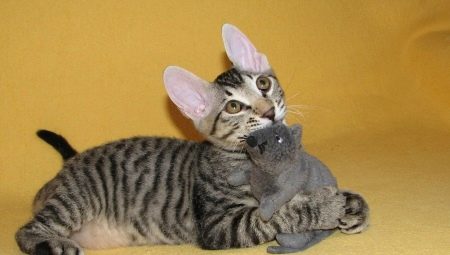The appearance of hairless sphinxes in the last century scared and delighted people. Many did not understand how to love a bald cat. After all, this animal should be soft and fluffy, pleasant to the touch, a real antidepressant.
Some twenty years passed, and the attitude towards the sphinxes changed. If you breed this breed, then expect a complete absence of wool. The Internet is full of indignations like: “I bought a sphinx, and it has a growing fluff, what should I do? Maybe he is not a sphinx? ”
There is no need to do anything - just love the animal. Sphinxes are different, and the presence of wool on some species is normal. To understand whether sphinxes have hair, we will give a description of some species of this animal.


Don Sphinx
In the late eighties of the last century, the first hairless cat was born in Rostov-on-Don. From it began the Don breed of sphinxes. In the Don breed, baldness is due to the presence of the dominant Hbl allele in the genotype. Four main groups of this species are distinguished: starved, flock, velor, brush.
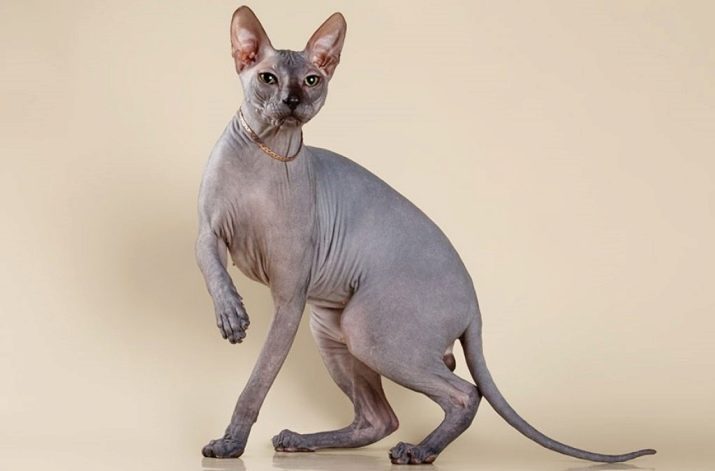
Holoborn ("rubber")
The name speaks for itself - kittens are born without a hint of hair. Moreover, they may not have a mustache and eyebrows, as well as sensitive hairs on the legs. The skin of such animals resembles rubber or plasticine, it is warm, sticky, with a lot of folds on the head and body. Babies can be born with their eyes open, as is the case in humans.
The finest elastic skin does not yet have a final color.The future color of the animal (blue, black, spotted) can be recognized by the pads on its feet. In winter, some individuals grow sparse, but in the spring it disappears.
Larger animals remain naked with many folds throughout their lives. They are of great interest to breeders.
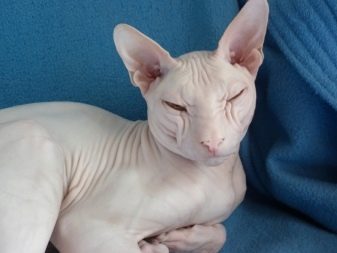
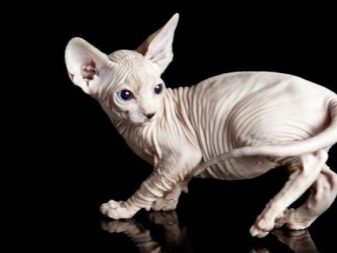
Flock
Kittens are born with a barely noticeable fluff over the entire surface of the skin, like peaches. The tactile sensations of touching their skin are very pleasant and unusual, cats resemble plush toys. By two years, the hairline is thinning, the bulbs die off, and the animals become completely bald.
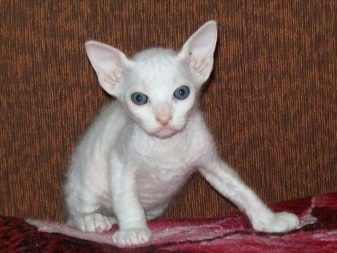
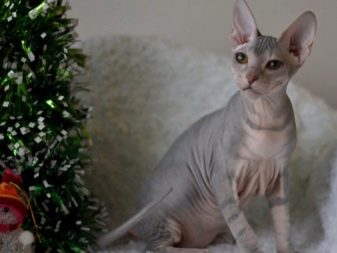
Velours
Velor, like flock, only visually looks bald - taking a kitten in your hands, you feel a soft fluff throughout your body, like a pile on velor fabric. Unlike the flock, on the animal of this type, the pile is longer and thicker, especially on the muzzle, legs and tail. The crown remains absolutely bald. Stroking the baby against the hair, you can notice how quickly his even hairline is restored.
Velor kittens are divided into types according to the state of their coat. Easy - has a minimum hair length of two millimeters. On the legs they are thicker than on the body. Some kittens have stiff hair, while others have soft hair. There is no wool on the crown.
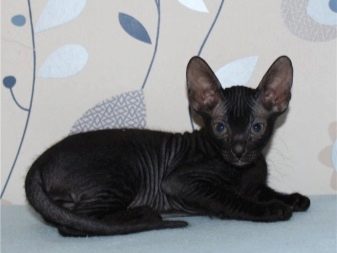
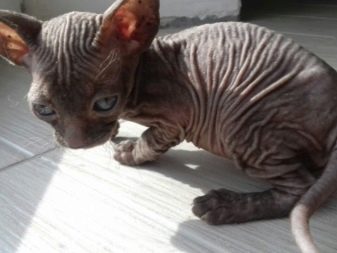
Point - wool has a relatively long pile (four millimeters) on its face, tail and limbs. Points arise in the winter, then their expressiveness decreases.
Downy look - the cat is completely covered with a gentle wavy, rather long pile. In addition, the animal has a surprisingly cute tail.
By the time of puberty, the velor sphinx is completely bald and only some cats walk with the rest of the fine hair on the legs and head.


Brush
Brush translates as "bristly." The hair of these animals really looks like an old brush - hard, rare and twisted. There are animals with a bald head, neck and limbs. This species is used to maintain the population, but they do not have values for the breeder, and they will not wait for titles at exhibitions. Brushes are good as a parent to continue the look. The fact is that you can not cross two naked individuals - this leads to mutations and stillborn kittens.
Brush can shed its hair by a year and a half, but this does not apply to its dense appearance. His coat is so thick that the skin cannot be seen through it. The tail has grown especially well with it, as well as a lot of hair on the legs and chest.


Canadian Sphinx
The history of the Canadian sphinx began twenty years earlier than the Don, when in 1966 a bald kitten was born with a domestic cat in Canada. Such phenomena occurred earlier, among different nations, but kids without wool were considered a mutation and rejected. Only a Canadian kitten interested breeders and became the progenitor of a new breed, which is called sphynx around the world. In Russia, the word “Canadian” was added to the name so as not to be confused with the Don and St. Petersburg.
Unlike the Don, the mutation of the Canadian species is expressed by the recessive alopecia gene. Most often, sphinxes retain even fine adulthoods of wool behind their ears, tail, limbs or nose, even in adulthood.
A slightly perceptible fluff of the skin gives a feeling of suede. With age, the pile may become thicker.

Differences between the Canadian and Don Sphinx
Cats without hair, with lots of folds, look like aliens. They are all called sphinxes, and not everyone knows that this breed has its own species that differ from each other. The Canadian and Don Sphinxes are endowed with the following differences:
- species have different baldness genes (dominant and recessive);
- Canadian sphinxes are always covered with a barely noticeable fluff, and the Don sphinxes can be absolutely woolless (“rubber”);
- Canadian individuals are endowed with large, round eyes, while Don individuals have an almond-shaped eye section;
- Canadians have no mustache at all;
- in the Don species, the tail has an average length and thickness, straight and quite strong, unlike Canadians, in whom the tail is weak, thin with a point at the end;
- Don individuals have a strong torso and a strong muscular system, in contrast to the underdeveloped muscles of Canadians.

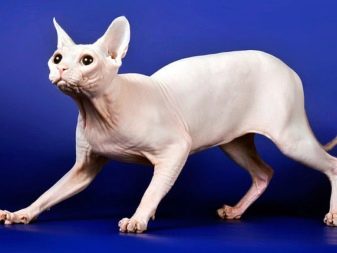
Petersburg Sphinx (Peterbold)
The breed was bred in St. Petersburg in 1994. The recessive gene is taken as the basis of baldness. The ancestors of the species were the Don Sphinxes. This breed is distinguished by an elegant, slender look, an elongated muzzle with oval eyes and huge ears diluted to the sides.
In addition to animals without wool, piterbolds, like the Don Sphinxes, have varieties of individuals with a wool coating: brush, velor, flock, straight-haired. Let us dwell on the latter variety, since the previous species were considered in the review of the Don breed.

Straight-haired
The species is based on the selection of Siamese and oriental cats with sphinxes. These animals lack the baldness gene; they have normal hair and mustache. The coat is short, tight-fitting to the body, in the eastern style. The color of the piterbold often repeats the color of its ancestors - the Siamese and oriental group.
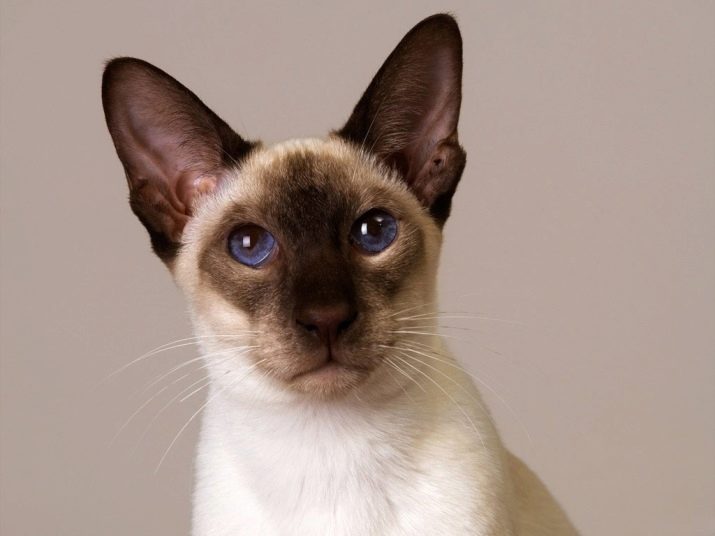
Why is sphinx fur?
The appearance of new hair on an animal of this breed, or, conversely, its disappearance after the growth of woolly kittens, is associated with many factors. There will be no definite answer. The reasons may be the following:
- vaccinations sometimes affect the appearance of hairiness;
- hormonal manifestations of an individual associated with the bearing of kittens;
- poor feed selection;
- weather;
- castration.
If the brood has perfect parents, but one of the kittens was still born with hair, do not forget that he had great-grandmothers and great-grandfathers who awarded the baby with hair.
In the end, the lack of hair reduces only the price of a kitten, but does not affect his character, sweet and good-natured, like all sphinxes.
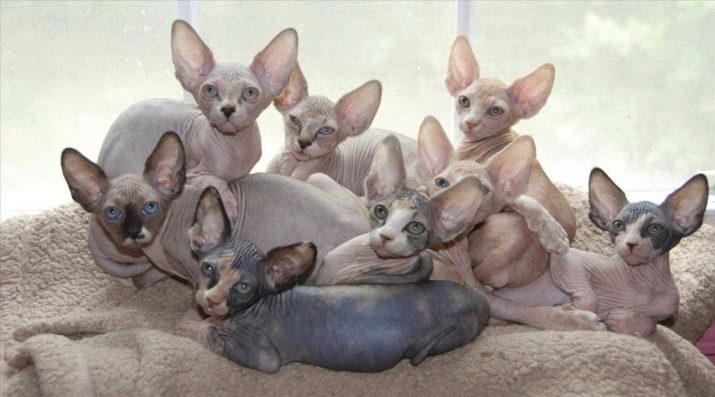
Interesting about the Sphinxes
- Hypoallergenicity of the sphinxes is a myth. Even in the absence of hair, the body of too sensitive people can react to sweat and salivation of the animal.
- Sphinxes stand out among the cat family not only for its fantastic appearance, but also for its canine character: kind, faithful, attached to its owner.
- Cats of this breed can easily get along with any pets, but if they were allowed to choose companions, they would prefer sphinxes.
- Sphinxes have large heat dissipation, so they like to eat tightly - only quick metabolism saves them from obesity.
- Before the breed became known, the owners tried to treat lichen mutated bald kittens.
- Cats like to sleep with their owners under the covers, resting their heads on the pillow.
- Sphinxes are able to sunbathe and sweat like people.
- Representatives of this breed live up to fourteen years, although there are cases when pets survived to the age of nineteen.
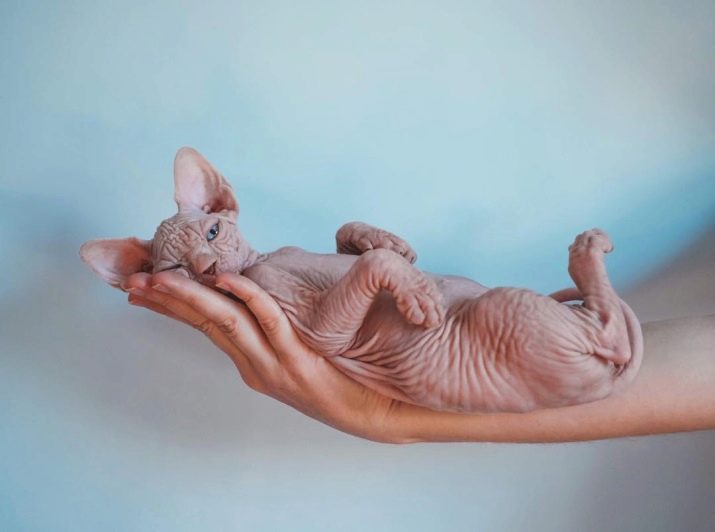
Sphinxes are unusual animals, they have a distinctive appearance, good intelligence and friendliness, that is, all that is needed for a great pet and a good friend.
You will learn more about sphynx cats with hair from the following video.
